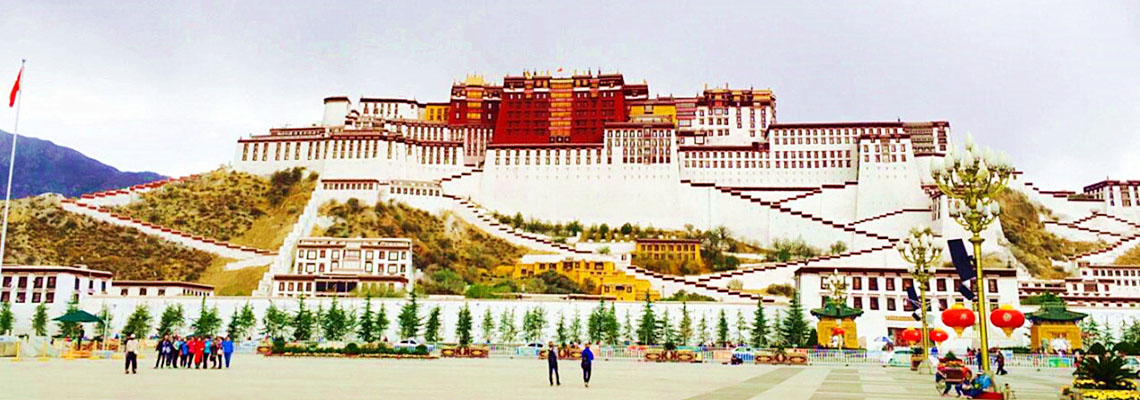
Day 1
BeijingInternational flight on your own arrangement. Once arrive in Beijing,be met and transferred to your hotel. Feel free at leisure for the rest of the day.
Day 2
Beijing-
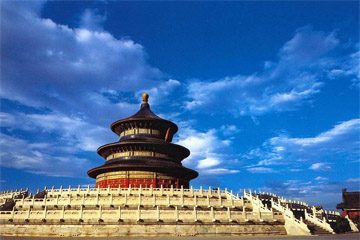
- The Forbidden City
After breakfast starts with a visit to the Temple of Heaven .You will see local people practicing Tai Chi,as well as singing and calligraphy in the neighboring park,and take a leisurely walk through Tiananmen Square to the Forbidden City, enjoy the panoramic view of Forbidden City form Jing-shan Hill .Sample Peking Duck Dinner before a fantastic Kongfu Show .
The Tian'anmen Square : The largest city square in the world.
The Forbidden City : The largest imperial palace in China during the Ming and Qing dynasties with a history of around 600 years.Located in the middle of Beijing, Forbidden City was the Chinese royal palace from the Ming Dynasty to the end of the Qing Dynasty. Also called Palace Museum, the Forbidden City is recognized as the most magnificent and splendid palace complex in China and one of the five world-famous palaces with the Palace of Versailles in France, Buckingham Palace in England, the White House in United States and the Kremlin in Russia.
The Temple of Heaven : Temple of Heaven ( Tiantan ) is located in the southern part of Beijing, and has been one of the most holy places for the whole country for more than five centuries. It used as a complex of sacrificial buildings for the Ming and Qing emperors, and is the largest one in Beijing among several royal altars to Heaven, Earth, the Sun, the Moon and other deities or symbolic forces of Nature.
Day 3
Beijing-
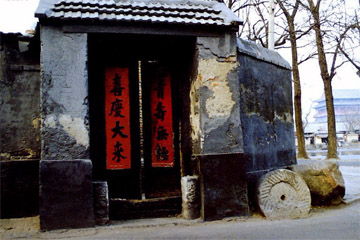
- The Ming Tomb
Morning head to visit the Great Wall, Ming Tomb .Then explore the alleyway -"Hutong" by riding on a traditional rickshaw to catch close-up glimpses of local life.
The Great Wall : One of the seven wonders in the world and the symbol of China.Badaling Great Wall is the most impressive and the most visited section of the Great Wall of China. Constructed in 1502 during the Ming Dynasty, the Badaling Great Wall once served as an important military fortification. Many leaders from China and around the world, like Richard Nixon, Margaret Thatcher…all visited this section of the wall.
The Ming Tomb : The only underground tomb of the thirteen tombs of the emperors in the Ming Dynasty.Some 50 kilometers northwest of the downtown Beijing, the Ming Tombs are generally combined with a visit to the Great Wall. Otherwise known as the “13 Tombs”, this is the burial site of 13 out of 17 emperors of the Ming Dynasty. However, the only one you can get a good look at is the tomb of Emperor Wanli, who reigned from 1537 to 1620. This tomb was unearthed in 1956. There are two others that have been uncovered, but the rest remain illusive.
Day 4
Beijing-
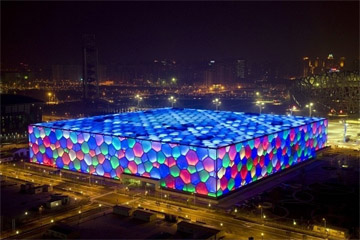
- Water Cube Aquatic Centre
Take a photo stop at the 200 Olympic Site to see the Bird's Nest National Stadium and Water Cube Aquatic Centre .Then explore the Summer Place-a former imperial summer resort. Then take the overnight soft sleeper train to Xi'an.
Bird's Nest National Stadium:The National Stadium, affectionately known as Bird's Nest, is situated in Olympic Green Village, Chaoyang District, Beijing. It was designed as the main stadium of 2008 Beijing Olympic Games. The Olympic events of track and field, football, gavelock, weight throw and discus were held there. Since October, 2008, after the Olympics ended, the National Stadium has been opened as a tourist attraction. Now, it's the center of international or domestic sports competition and recreation activities .
Water Cube Aquatic Centre:Located on the west side of Landscape Avenue in the Olympic Green and to the west of Beijing National Stadium(Bird's Nest), the National Aquatics Center contains the official 2008 Olympics swimming facility. It measures 177 meters (194 yards) long, 177meters wide, and 30 meters (98 feet) high and covers an area of 62,950 sq meters (75,287 sq yard). It has four floors: one at street level, two above, and one below.
Summer Place:Situated in the Haidian District northwest of Beijing City, the Summer Palace is 15 kilometers (9.3 miles) from central Beijing. Being the largest and most well-preserved royal park in China, it greatly influences Chinese horticulture and landscape with its famous natural views and cultural interests, which also has long since been recognized as 'The Museum of Royal Gardens' .
Day 5
Xi'an-
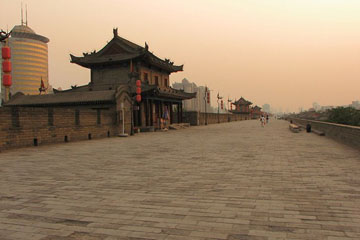
- The Ancient City Wall
Morning arrive Xi'an,you will be met and transferred to your hotel.This afternoon stroll on the original City Wall,Which you have opportunity to cycle on this ancient wall,and then explore the Old Muslim Quarter and Old Mosque.Tonight enjoy a local specialty-dumpling dinner before the famous Tang Dynasty culture show.
The Ancient City Wall : An extension of the old Tang Dynasty structure boasting the most complete city wall that survives through Chinese long history.The City Wall has corner towers, ramparts, sentry towers, gate towers, battlements and a a number of city defensive fortifications with very strong defense capability.
Old Muslim Quarter and Old Mosque:The Great Mosque is a Chinese traditional Alhambresque architecture with a long history and grant scale, which is the great combination of Islamic and Chinese culture. It was recorded that it was established in the first year of the Tian Bao reign by Li Lung Ji, after renovations and expansions on several occasions in the Song, Yuan and especially the Ming and Qing Dynasties, it gradually takes on the current performance. The Great Mosque and the Muslim Quarter now is the important relic preservation of Shanxi Province and the national important relic preservation of third period.
Tang Dynasty culture show:If you prefer a night performance to kill your night time, Tang Dynasty Show is your best choice, which is on the most Xian visitors' top 10 attractions list. The Tang Dynasty Show showcases the costumes, music, and dancing of China's golden age: the Tang dynasty (618 - 907). The show begins with an ancient Chinese musical instrument ensemble while you dine and then later the cultural dance segment begins. The costumes are splendid and you can get some really nice photos if you sit near the stage.
Day 6
Xi'an-

- The Terra-cotta Warriors and Horses :
After breakfast visit the historical significance of the amazing The Terra-cotta Warriors and Horses -where7000 individually crafted clay soldiers stand on guard.Then continue to the Bid Wild Goose Pagoda built to house Buddhist scriptures collected by a Chinese Monk,where you can see variety of buddha statues before flying to Lhasa .
The Terra-cotta Warriors and Horses : The greatest archaeological findings of the century: the army of terra-cotta warriors and the bronze chariots entombed in vast underground vaults at emperor Qin's tomb.
The Wild Goose Pagoda: The pagoda where widely renowned Master Xuanzang (Monk Tripitaka) stored his classics brought from India. Big Goose Pagoda is one of the oldest structures in China. Originally Big Goose Pagoda consisted of a brick structure of five stores and was about 60 meters high. First built in 589A.D.in the Sui Dynasty. Between AD 701 and AD 704 during the reign of the Empress Wu Zetian five more stores were added to the pagoda making ten in all.
Day 7
Lhasa-
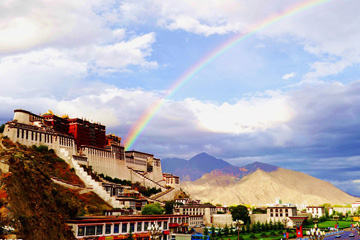
- Polata Palace
Visit the world-famous architectural wonder-the Polata Palace,which towers over the entire mountains and the lake below is simple gorgeous.This is where the Dalian Lama spent his winters.You will also visit the Jokhang Temple,which is known as the most sacred place in Tibet-thousands of Pilgrims from all over Tibet come here to pay homage. Finally enjoy wandering through a market at Barkor Circuit.Sample a Tibetan specially dinner.
Polata Palace:Situated on the Red Hill of central Lhasa, Potala Palace is the highest ancient palace in the world, reaching 3,767.19m (12,359.55ft) at the topmost point.Potala named after a holy hill in South India is a Sanskrit word meaning "Abode of the Avalokitesvara (Buddha of Mercy)." Legend has it that in the 7th century, to greet his bride Princess Wen Cheng of the Tang Dynasty (618B.C. - 907B.C.) of China, the then Tibet King Songtsen Gampobuilt a 9-storey palace with a thousand rooms up on the Red Hill and named it Potala. Later, with the collapse of the Songtsen Gampo Dynasty, the ancient palace was almost destroyed in wars.
Jokhang Temple:The Jokhang Temple, situated in the centre of old Lhasa, was originally built in 647 AD. The site is said to have been chosen personally by the wife of King Songtsan Gampo, the Tang Princess Wencheng. It was built by craftsmen from Tibet, China and Nepal and thus features an intriguing mix of architectural styles.Jokhang Temple is the spiritual center of Tibet and the holiest destination for all Tibetan Buddhist pilgrims.
Barkor Circuit:Located in the old area of Lhasa City, Tibet, Barkhor Street is a very ancient round street surrounding the Jokhang Temple and the Tibetan people are always proud of it. As a symbol of Lhasa, this street is also a must-see place for the tourists.It's said that in 647, the first Tibetan King Songtsen Gampo (617 - 650) built the Jokhang Temple.
Day 8
Lhasa-
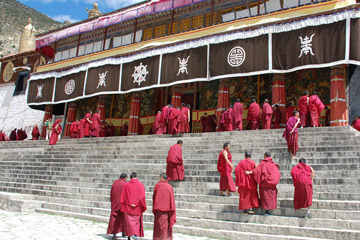
- Sera and Drepung
Explore some of the largest and most impressive monasteries of Tibet-Sera and Drepung.Watch the monks debating.You will also stop at Norbulingka Park,the site of the Dalian Lama's Summer Palace.Take a backstreets walking tour of the Tibetan Quarter,and overlook the Lhasa Valley from the hilltop at Pawang Ka.
Sera and Drepung:Situated at the foot of the Mountain Gambo Utse, 5 kilometers (3.1 miles) from the western suburb of Lhasa, the Drepung Monastery is known as the most important monastery of Gelugpa in Tibetan Buddhism. It is considered one of the 'Three Great Monasteries' (the other two are theGanden Monastery and the Sera Monastery. Covering an area of 250,000 square meters (299,007 square yards), it held 7,700 monks in total and possessed 141 fazendas and 540 pastures in its heyday, and is the largest-scale monastery among the ones of the same kind. Seen from afar, its grand, white construction gives the monastery the appearance of a heap of rice.
Norbulingka Park:Norbulingka, meaning 'Treasure Park' in Tibetan, is situated in the western suburb of Lhasa City, at the bank of the Kyichu River, about one km (about 0.6 mile) southwest ofPotala Palace. The garden covers an area of 360,000 square meters (about 430,000 square yards), with 374 rooms inside. It is the biggest man-made garden in Tibet Autonomous Region
Day 9
Lhasa-
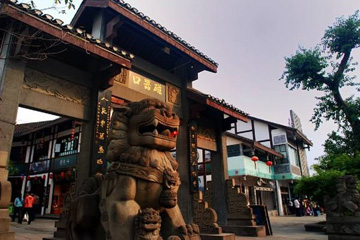
- Erling Park
After breakfast take the flight to Chongqing,the starting point of Yangtze River.Visit Ciqikou Old Town where you can walk along centuries-old streets lined with wooden house,an ancient pier and observe authentic and busy local life,and then drive to the Erling Park to see the great views of Chongqing city and the Yangtze River showing the water levels before and after the construction of the Three Gorges Dam.After sample a local specialty dinner,board on your cruise ship.
Ciqikou Old Town:Perched on a hill overlooking the Jialing River in the west of the city, Ciqikou Old Town (Porcelain Village) dates back to the late Ming Dynasty (1368-1644). People always said "One flagstone road, and one thousand years' Ciqikou". This is never more true than when you visit Ciqikou Old Town where you will find the local residents dedicated to their traditional way of life, unaffected by modern influences to be found in the larger towns and cities. It is similar to the Jinli Ancient Street in Chengdu, but Ciqikou is bigger than that.It was named as it had supplied large amount of porcelain dating during Qing and Ming Dynasty. However, the village was also an important supply post for shipping on the river, a fact that explains why there are so many shops lining the twelve lanes paved with their large flagstones that form the main routes. Here you will find many outlets for craftwork, groceries and the like as well as a horologist, photography supplies, drugstore and a tempting supply of roasted nuts and seeds.
Erling Park :Located on the Eling Hill (Goose Hill), the Eling park used to be an ancient private garden named "Li Garden" made by Mr.Li Yaoting from 1909-1911 A.D. With its good location and beautiful natural scenery, it is one of the best places to have a birds-eye-view of the whole city.On the crest of the city, Eling Park graces Chongqing with delicate miniature landscapes. Nanshan, Wangshan and Mt. Jinyun with age-old trees and bamboo groves are worth visiting. Swimming and bathing in the Hot Springs of the Southern and Northern Parks appeals to all.
Day 10
Yangtze River Cruise-

- Xiling Gorge
Sail through Xiling Gorge,Wu Gorge and Qutang Gorge and enjoy the magnificent views of various shapes of peaks,rolling rills and small towns along the river.Also you shall undertake on-shore excursions to the Ghost City of Fengdu,take a Sampan(wooden boat)tour to one of the Yangtze's tributaries,pass through the world's biggest five level ship lock.
Xiling Gorge:Xiling Gorge is mainly composed of smaller gorges and dangerous shoals. From west to east, there are four gorges - The Military Books and Precious Sword Gorge (Bingshu Baojian Xia), The Ox and Horse Lungs Gorge (Niugan Mafei Xia), Kongling Gorge, and Lantern Shadow Gorge (Dengying Xia) - and some dangerous shoals such as Qingtan, Xietan, Xintan and Konglingtan .
Wu Gorge:The Wu Gorge is the second gorge of the Three Gorges of Yangtze River and is famous for its elegance. Winding over 25 miles, it starts from the estuary of Daning River (east of Wushan) in the west and ends at Guandukou in Badong, Hubei Province .
Qutang Gorge :Qutang Gorge, the shortest and most majestic of the Three Gorges, winds five miles from Baidi City in Fengjie County to Daxi Town in Wushan County. The two banks of the Qutang Gorge contain numerous scenic spots.
Ghost City of Fengdu:Located on the Ming Mountain on the northern bank of the Yangtze River, Fengdu County is known to most Chinese as the 'Ghost City'. Having nearly two thousand years' history, the Ghost City combines the cultures of Confucianism,Taoism and Buddhism with the mystique of ghosts. Many famous literary works like Journey to the West, Apotheosis of Heroes and Strange Tales of a Lonely Studio contain vivid references to Fengdu.
Day 11
Yangtze River Cruise-
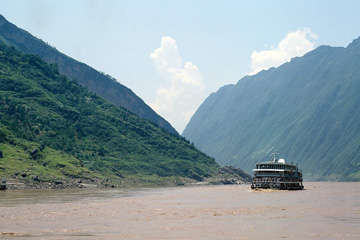
- Three Gorges Dam Project
Today experience the Tai Chi morning exercises ,visit the Three Gorges Dam Project,enjoy a variety of Chinese cultural activities on board,such as Chinese brush painting shows,Chinese silk embroidery lessons.
Three Gorges Dam Project:"Three Gorges Dam Project" is the short term for the water control project at the three gorges on Yangtze River. It is located in the middle section of Xiling Gorge (one of the three gorges on Yangtze River) near Sandouping Town inYichang City, Hubei Province. Being the world's largest hydropower project, Three Gorges Dam Project has created many "Firsts" such as the most efficient dam in flood control, the most difficult construction work and the largest migration project in the world.
Tai Chi :is a centuries-old Chinese martial art that descends from qigong, an ancient Chinese discipline that has its roots in traditional Chinese medicine. (The people that you see moving gracefully in parks in China are practicing tai chi.) According to some records, tai chi dates back as far as 2,500 years! It involves a series of slow, meditative body movements that were originally designed for self-defense and to promote inner peace and calm.
Day 12
Chongqing-

- shanghai
After breakfast you will take the early flight to Shanghai and check into the hotel . Then visit the Shanghai Museum and after dinner visit the Bund and enjoy the boat cruise on the Huangpu River.
Shanghai Museum: Shanghai Museum used to be near the Bund area. It is now situated in People's Square and its new buildings were built in 1996, designed by a Shanghai architect named Xing Tonghe. The new design symbolizes China's ancient understanding of the world: round sky and square earth. The museum has a circular roof and rectangular base. It stores 120,000 precious artifacts, which narrate a story of China's 5,000-year civilization.
Bund: This symbol of Shanghai is known worldwide as the ‘gallery of international architecture.’ Its assortment of buildings standing along the Huangpu River varying in height, color and architectural design make it one of the most magnificent skylines in the world.The Bund is Shanghai's most characteristic landscape. Over one hundred years, it has emerged as a symbol of Shanghai. It is located between the Nanpu Bridge and the Waibaidu Bridge in the West Bank of Huangpu River, with the total length of four kilometers. It is one of the new ten landscapes of the Shanghai 90s and the top ten tourist attractions. The Huangpu River, Long Beach, Green Square, as well as magnificent architectural complex together constitute a spectacular Shanghai incomparable landscape.
Huangpu River:Huangpu River is a branch of the lower reaches of theYangtze River. It lies in Shanghai City, formerly known as Huangxiepu or Chunshen River. It takes its rise from theTai Lake, runs eastwards through the Dianshan Lake in Qingpu County and then flows to Minhang District in Shanghai. At the Baidu Bridge in the center of Shanghai City, Huangpu River flows together with the Wusong River (i.e. Suzhou River) and finally flows into the East China Sea.
Day 13
Shanghai-
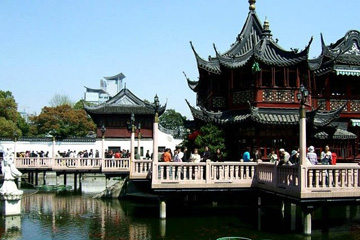
- Yuyuan Gardens
In the morning you will visit Yuyuan Garden and Jade Budda Temple, and the rest of the day is free for you.
Yuyuan Gardens: A famous garden of beauty and tranquility in the heart of Shanghai built during the Ming Dynasty 400 years ago as a son’s gift to his parents.Black tiles and white walls establish a nonchalant and simple keynote . The dainty style makes one feel comfortable, and each exquisite window lattice is telling its own story, serves the record of the past delicate life. Every piece of roof tile is passing a sort of affection of pride and memories.The entire Yuyuan Garden is bordered by the Dragon Wall.
Jade Buddha Temple:A beautiful Buddhist temple constructed in 1882 housing two spectacular, imported, jade, Burmese Buddhas.
Day 14
Depart ShanghaiIn the morning you will be transferred to the airport and take the flight back to your hometown.
| Travel in party of |
Superior Class ★★★★★ |
Deluxe Class ★★★★ |
Tourist Class ★★★ |
| 2-5 persons | N | $ | $ |
| 6-9 persons | N | $ | $ |
| 10 persons & above | N | $ | $ |
| Single room Supplement | N | $ | $ |
Service included:
2 Meals as listed in the itinerary, B=breakfast; L=lunch ;
3 Personal Guide & Driver + Private car / van for Private Transfers & sightseeing
4 Hotels with breakfast(twin share bases) as listed in the itinerary .
5 Domestic flights or trains as listed in the itinerar
6 Airport Taxes: US$30for domestic,
7 Service Charge & Government Taxes .
8 Luggage Transfers between airports and hotels
9 Goverment letter for visa support
Service excluded:
2 Personal expenses, tips to the guide and driver.
Note, the price for 6-10 pax included Lunches and Dinners1 Entrance fees/
2 Meals as listed in the itinerary, B=breakfast; L=lunch ;
3 Personal Guide & Driver + Private car / van for Private Transfers & sightseeing
4 Hotels with breakfast(twin share bases) as listed in the itinerary .
5 Domestic flights or trains as listed in the itinerar
6 Airport Taxes: US$30for domestic,
7 Service Charge & Government Taxes .
8 Luggage Transfers between airports and hotels
9 Goverment letter for visa support

